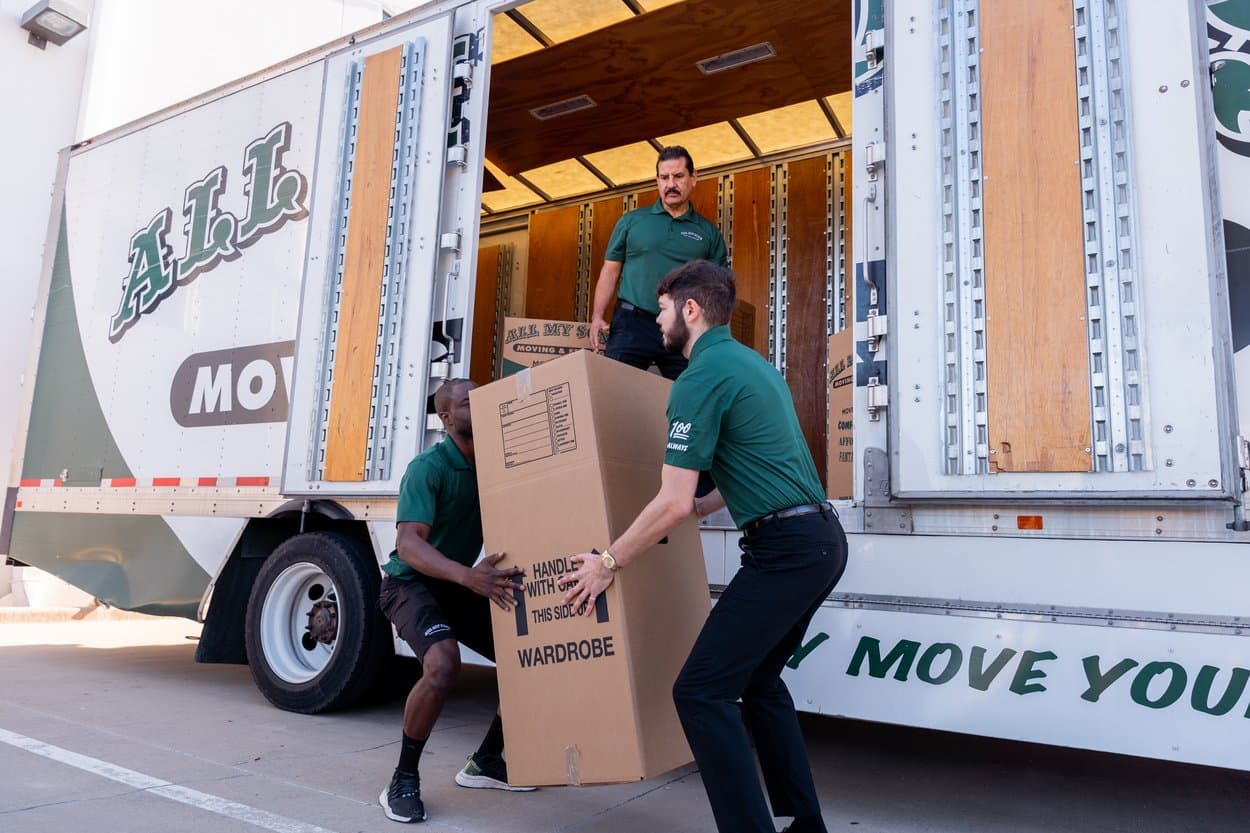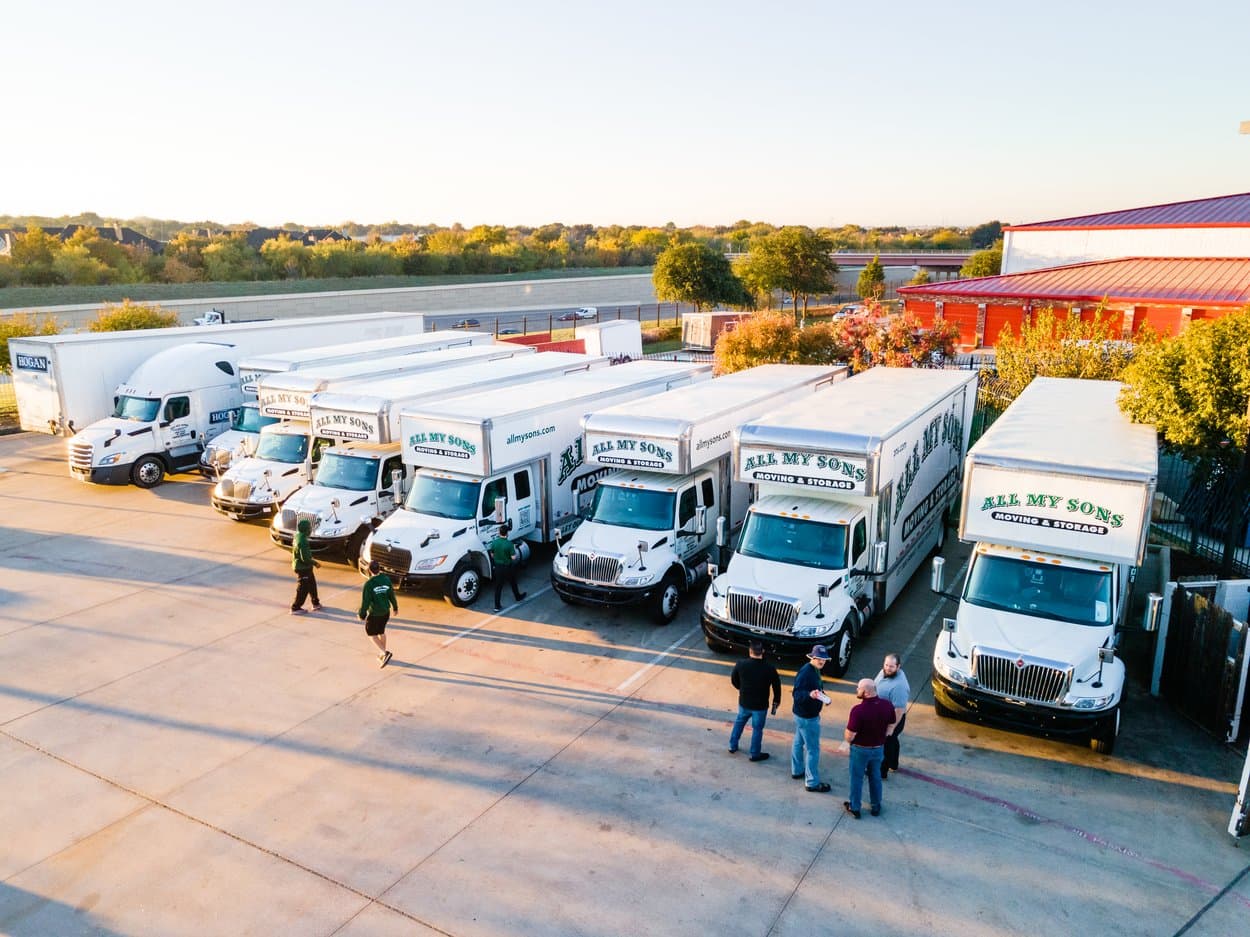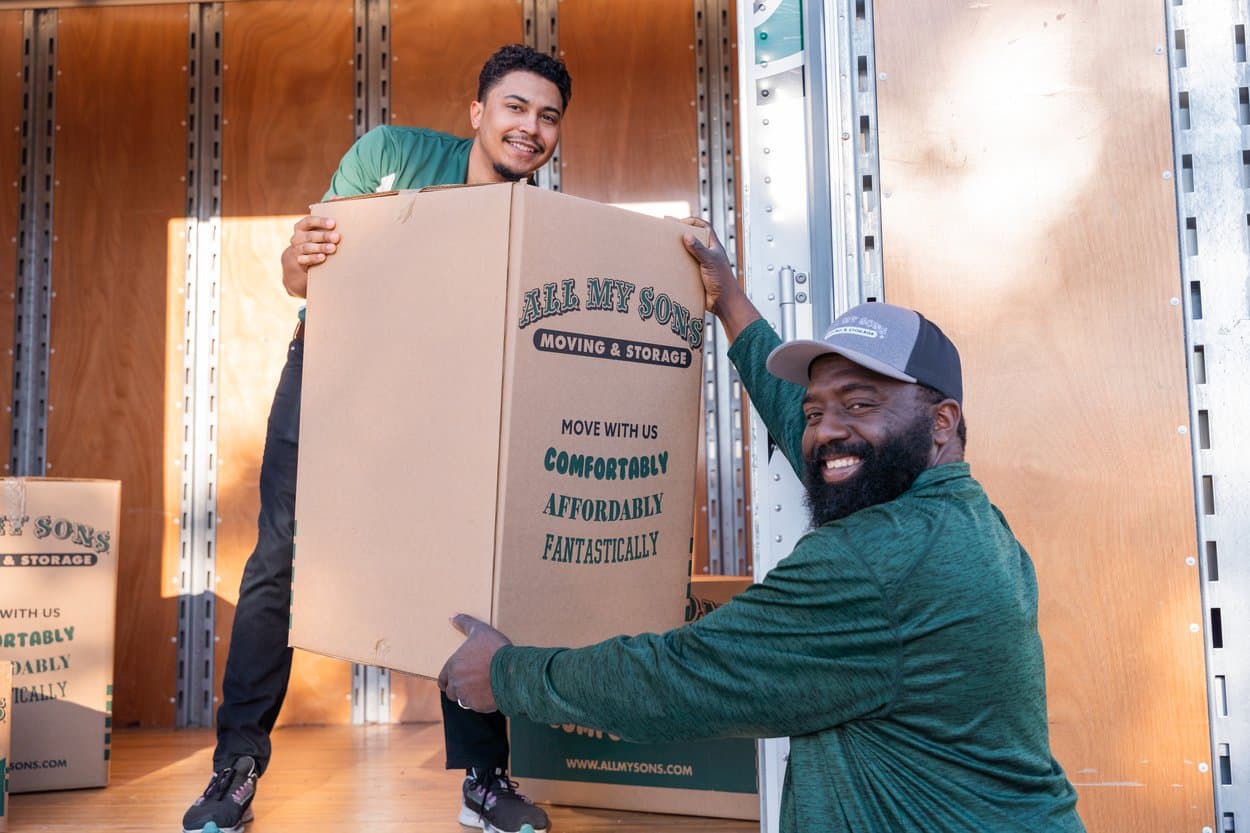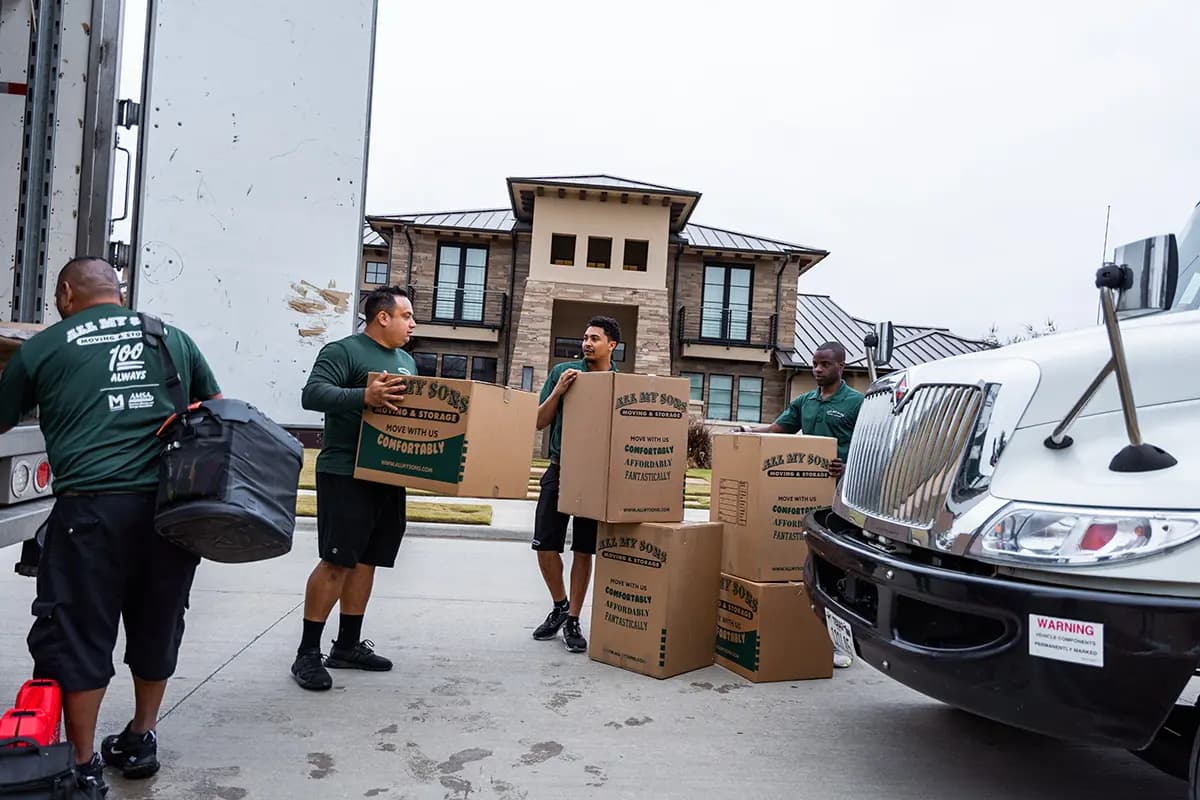Moving Time Means Spring Cleaning
Want to save time and money on your move? Decluttering is the name of the game.
As every mover knows, a move becomes so much more manageable when there is less stuff to move. Not to mention that when the excess is gone from your life, you’ll have a much easier time organizing your new home. You can start your next chapter feeling lighter with less junk you don’t need lying around.
The only problem is deciding what to offload. Some of those decisions can be tough, especially if certain things hold sentimental value.
At All My Sons Moving & Storage, we help companies and families make a swift and stress-free relocation. An organized move is an efficient move, and we want to empower our customers with the tips and tricks that will help them get organized. If you’re looking to move, decluttering and downsizing is a great way to start the process.
Looking at your mountain of belongings and feeling a little overwhelmed? We’ve all been there. The easiest way to start your decluttering process is to take things one step at a time, room by room, until the monumental task is accomplished. You can start small by tackling just your bathroom counter and then moving up to the bigger spaces in your current home.
As you declutter, keep three separate containers on hand to categorize your belongings. These containers will be:
Keep: The items going into the moving boxes and coming with you.
Donate or Sell: Items that you no longer want or need but are in good condition and can be used by another person.
Dispose Of: Items that are destined for recycling or trash because they are not in good condition or would be meaningless to another person.
Getting set up and started is often the easy part. Some items will be challenging to categorize.
Here's an easy reference list that can help you make some of those tough decluttering decisions.
Keep: Items You Use Often
As you consider your items, the things you need and use daily should always come first. These are your non-negotiables and must-haves. Everything else you own will have to take a back seat to these solid and unwavering keeps.
When determining your absolute essentials, ask yourself these important questions:
How often do I use this item? Appliances you use rarely, clothes you wear once in a blue moon, and décor items you forget to admire on the daily all have a mark against them.
When will I need this item again? It may be that you don’t use an item often, but you can name a time in the immediate future that you will need the item. If the answer is a nebulous “someday” then you should probably steer that item away from the essentials.
Can a smaller version of this item meet my needs? Big bulky items could still be items you use daily, but would a less spacious replacement work for you?
Would someone else possibly make more use out of this item? Items you use only occasionally might get better, more consistent use with another person. Consider giving these items away.
Remember that the idea of decluttering is to make your move and your new life lighter. If something has to go, then the essentials always beat out the would-like-to-keeps.
Get Rid Of: Broken, Expired, or Ill-Fitting Items
This is the land of true junk. These items are lying around and taking up precious space in your home without giving anything back. You might not be an actual hoarder, but you’re hanging onto these things anyway. Maybe these are sentimental items or the logistics of getting rid of them pose a problem. You’ve let them sit long enough.
Comb the pantry, the back closets, and the medicine cabinet. Are there items with clear expiration dates on them? If the date is past, then it’s time to throw the item out. If the date is approaching soon and you do not anticipate using the item, then get ahead of the game and toss the item now.
Clothes that are ruined or torn should be discarded or recycled. If a piece of clothing is in good condition but no longer fits, it is best to donate or sell the item rather than continue to hang onto it. Remember, an item you will use again a nebulous “someday” should be steered away from the essentials.
Sentimental items that are broken might be more difficult to part with. Ask yourself some important questions before you allow the item to continue to take up space in your home.
Can this item be repaired in a reasonable amount of time? If the item cannot be repaired or the repair will take more time, money, or energy than you currently have, consider letting the item go.
Can I preserve a picture of this item instead of the item itself? Sometimes what you value most about an item will be the memories you associate with the item. Ask yourself if you can keep the memories by taking pictures of the item to cherish and treasure.
Can I preserve a piece of this item instead of the item as a whole? Sentimental items could potentially be upcycled into a new creation. You could cut a bunch of old t-shirts into a quilt or assemble a dozen kids’ drawings into a scrapbook. Keep in mind, your time and energy are limited. Ask yourself exactly when you’ll have the space and motivation to work on a preservation project, and let that answer help you determine whether to keep a sentimental item.
Can I accept that this item served its purpose and let go? Sometimes items, like people or places, enter our lives for a time but that time eventually passes. You can look back on your time with this item fondly and still choose to let the item go.
Got bulk junk like busted appliances and ruined furniture? Letting go might be the easiest decision in the world, but the actual ‘getting rid of’ part poses a problem. Rather than deal with the headache, you’ve let your bulk trash linger. The time has come to deal with it. Why not call Junk.com for quick, stress-free junk removal? Junk.com will take away old furniture, appliances, scrap metal, electronics, and more. Book now to get a team out to appraise your junk.
Keep: Items that Bring You Joy
Décor, keepsake, and hobby-related items might not be essential to your day-to-day existence, but they are essential to your emotional well-being. If you strip the walls and the shelves bare, is a home even yours? While it’s important to be selective when you are cutting the clutter, you shouldn’t purge your home of everything that makes you happy.
Take a moment to peruse the following questions as you evaluate your collectibles, memorabilia, and stuff you keep for fun.
What emotions do I feel as I consider this item? Pictures and artwork that evoke happy, jubilant feelings should go to the keep container. You might even choose to keep things around that evoke bittersweet memories like a photograph of a loved one who has passed on. Do not keep items that make you feel nothing. Strong negative emotions and indifference are big indicators of time to let go.
Do I display this item? Your home should have personal décor that you love. Sentimental items you always have out are big contenders for the keep pile. Sentimental items that have been forgotten in a back closet, not so much.
How often do I admire or think about this item? Display items should produce a constant stream of dopamine. Do you delight in seeing this item on your shelf every time you pass by? Do you enjoy showing it off to friends and family when you have guests over? If something is so invisible to you that it might as well be part of the wall, then you should probably replace it with something that does bring joy.
Cut the clutter, not the joy. Keep things you love in your life.
Get Rid Of: Duplicates
Somehow you ended up with multiple copies of items that serve the same purpose. Could be that you were gifted with two different colored coffee makers, or you bought a slightly different toolkit not realizing you already had one at home.
Take stock of your items that do similar things and ask yourself the following questions.
Do I have similar items to this item? If you have a closet full of black dresses, then you might consider keeping only your absolute favorites to make some space in your wardrobe.
How many of these items do I need? Sometimes one well-maintained item will work in the place of two similar items. If you have three sets of cereal bowls, ask yourself if just one set will serve its purpose.
Is there one I prefer over the others? When you find yourself gravitating toward the same item more than its duplicate, that’s a clear indicator of the one you should keep. Even if you really like the duplicate, if you aren’t using it much then you should steer it to the donate or sell container.
Offloading duplicates is one easy way to simplify your home inventory.
Keep: Items Not Easily Replaced
Some items in your household inventory will hold special significance because of their personal or monetary value. These are the items that probably should not be donated either because they are too valuable to give away or they would be meaningless to another person. A few of your things you won’t be able to put a price tag on.
Consider these questions to evaluate items that are difficult to replace.
How easy was this item to obtain? If an item can be purchased again in the future without much hassle then that’s a point toward the donate or sell container. Items that would be difficult to get ahold of again may steer toward the keep container.
How much is this item worth now? Think about the actual monetary value of the item and how this has changed over time. An item that was expensive to purchase but has depreciated in value might not be worth keeping.
How long do I need to hang onto this item? Some items you will choose to keep for a certain length of time, and some items you can’t fathom parting with ever.
Would this item be meaningful to another person? Items of significant personal value you might choose to hang onto indefinitely but consider what may happen to the item after you are gone. Would a family member, friend, or museum want this item? If the answer is no, then you might need to evaluate why you are keeping the item and what you are willing to do to preserve the item for just yourself.
The longer you live, the more items of personal significance you will accumulate so think carefully about what you consider irreplaceable. Revisit the questions for broken, expired, or ill-fitting items before you decide that you cannot let go. You might be able to preserve memories in pictures, take pieces of your sentimental items, or just accept that an item served its purpose and let go.
Get Rid Of: Items You Can Digitize
Media collections, old documents, and photo albums take up a lot of space. You can transform all those bulky items into easily stored and searchable files, which could even prolong the life of the item.
If you have old home videos on tape or mountains of scrapbooks, you could possibly hire a digitization service and save those collections from the inevitable wear and tear of time. Once digitized, these items can live safely in a hard drive or online cloud, which might preserve them in the event of a home disaster.
Ask yourself the following questions about your items.
Can I scan this item and keep a copy digitally? Old bills, photographs, or sentimental notes are all great candidates for digitization.
Can I purchase a digital copy of this item? Media collections like CDs, DVDs, and books can often be purchased in a digital form. Ask yourself if a digital copy of the item will serve your needs.
Can I access this item again digitally? If you have a DVD copy of a film you can easily access through streaming, ask yourself if you need the security of having the physical copy. It’s possible the answer is yes for your absolute favorites.
Digitized items, when stored in an online cloud, will be accessible again even if something happens to your home like a flood, fire, or tornado. While there are certainly risks of something happening to your online cloud, the benefits could outweigh the downsides.
Move Lighter After Decluttering
After you run through this list of what to keep and what to offload, you can start your big move feeling much lighter. Once the excess and junk is gone from your life, you’ll have a much easier time getting packed for your move and setting up a more organized life in your new home will be a breeze.
Now that you’re done with the decluttering, make your move a comfortable, stress-free experience and have All My Sons Moving & Storage handle all the heavy lifting. As a full-service moving company, we can perform professional packing services for your local or long-distance move. Whether you’re moving houses, apartments, or your office space, All My Sons Moving & Storage can handle all the details so that you can focus on settling into your new home.
Quick Moving Tips

How to Pack Clothes for a Move
All My Sons Moving & Storage provides professional packing services and has some special tips for packing your clothing for moving.

How to Make a Seamless Business Move
Tips for pulling off your business move from the experts in commercial moving services at All My Sons Moving & Storage.

How to Pack a Computer for a Move
Here are 5 steps that should help you get your computer secured for the move.


